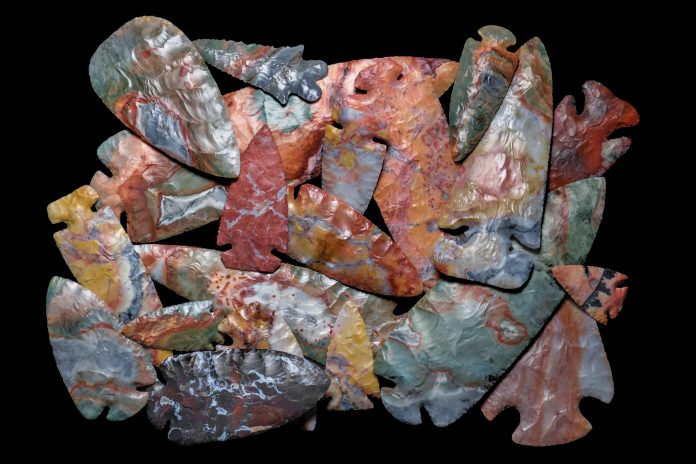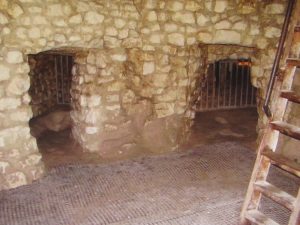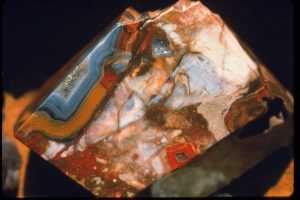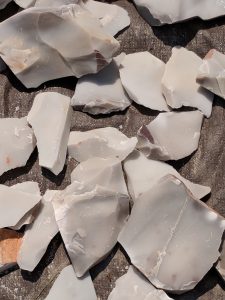
Flint rock was once the most widely used material in human history. Readily available, extraordinarily durable, and easily worked, it was the first mineral commodity to be systematically mined and traded. Vital to early human survival and development, flint rock (also called chert) is truly our “rock of ages.”
Although no longer of major economic or technological importance, flint still captures the attention of geologists, paleontologists, archaeologists, historians and lapidaries. The word “flint” also appears in the names of many topographical features, towns, and even a national monument. Two states honor flint as their official gemstone or rock.

Flint Rock or Chert: Geological Distinctions
The words “flint” and “chert” refer to the same fine-grained, chemical-sedimentary rock. Geologists favor “chert,” while historians and paleontologists prefer “flint.” Archaeologists consider chert as the raw material from which flint rock artifacts are made. Some writers use “flint” for nodules and “chert” for bedded occurrences. Others consider flint a dark variant of chert or a high-grade chert with finer grain and superior workability.
This article uses both terms depending on geological or historical contexts.
Flint is an impure form of chalcedony, which consists of interlocked, microscopic crystals of quartz (silicon dioxide, SiO2). Because it is impure and varies in composition, flint is technically a rock. Its main impurities are mogánite (hydrous silicon dioxide) and related forms of hydrated silica.
Flint Rock Properties and Geological Occurrence
Most flint is gray or brown, but traces of iron and manganese oxides often impart red, yellow, blue and purple hues. Black flint contains elemental carbon from organic sources, while white flint is pure chalcedony.
Flint forms from the solidification of silica-rich solutions or the alteration of silica-rich materials through three basic processes: compaction and crystallization of microscopic, siliceous skeletal structures; precipitation of silica from seawater; and the replacement of calcite in limestone. Flint occurs as both nodules and bedded seams, often within limestone or chalk formations. Nodules form when gelatinous silica fills cavities and solidifies; bedded flint forms when silica replaces calcium carbonate in sedimentary seams.
Unlike chalcedony with its orderly intergrowth of tiny quartz crystals and fibrous structure, flint has an irregular, particulate structure. Flint’s most notable physical property is its distinct, conchoidal fracture—its tendency to fracture into smoothly curving, concave surfaces shaped like the insides of bivalve mollusk shells. (The word “conchoidal” stems from the Greek konchoeidēs, meaning “like a mussel.”)
Conchoidal fracturing begins when an edged or pointed object strikes flint, initiating fracturing and generating a shock wave of mechanical energy that instantaneously radiates from the point of impact at a slight declination from the surface. As the energy moves toward the area of least resistance, the developing fracture steers itself back toward the surface to displace a thin flake of flint and leave a conchoidal depression. With systematic flaking, skilled craftspeople, called “knappers,” can shape flint into a variety of pointed and sharply-edged weapons and tools.

Flint Rock in Early Human History
Early humans began using naturally shaped stone implements some three million years ago, slowly improving the utilitarian effectiveness of these crude tools by chipping away sections in a process called lithic reduction. Pointed or edged stone tools with shapes completely modified for specific uses began appearing about one million years ago. By then, stoneworkers had realized that certain types of stone—mainly flint—had superior durability and workability. By Neolithic times, flint artifacts were exhibiting high levels of symmetry, detail, and functionality.
Archaeologists believe that man first created fire about 250,000 years ago by striking pyrite (iron disulfide) with sharp pieces of flint. This exerted extreme mechanical pressure on a tiny area of the pyrite, separating the pyrite’s atomic bonds and releasing heat and light energy as a shower of sparks.
As a major technological advancement, flint-pyrite fire-making radically altered human behavior. Small, easily transportable flint-pyrite fire-starting “kits” facilitated the human migration from Africa that began some 200,000 years ago.
Flint’s importance in fire-making grew during the Iron Age when metalworkers learned that iron, when struck with sharpened flint, shattered into tiny metal particles that oxidized instantly in atmospheric oxygen to create much hotter sparks than those produced with pyrite. Flint thus became a key component of the flintlock firearms that appeared in the late 1500s and featured shaped flints attached to spring-loaded metal arms. When the arm moved forward, the flint struck an iron plate to create sparks that ignited the gunpowder. During the 1700s, gunflint manufacturing was a major industry in Europe, where factories produced more than 50 million precisely shaped gunflints each year.
Flint also served architectural purposes. The ruins of several large Roman fortresses in England consist entirely of rough flint nodules. And during the 1700s, many English churches were built of flint that had been knapped into precisely sized “bricks.”

National Park Service
Flint’s Origins in the Great Oxygenation Event
Many of the Earth’s large, bedded flint deposits formed during the Great Oxygenation Event (GOE), a lengthy, global, biochemical transition that began more than three billion years ago when the Earth’s atmosphere was devoid of oxygen and its acidic seas were rich in dissolved iron and silica. The GOE began with the proliferation of cyanobacteria, simple, algae-like life forms that obtained energy from photosynthesis and released free oxygen. The availability of this free oxygen decreased seawater acidity and oxidized the dissolved iron to precipitate huge quantities of iron oxide and silica onto seafloor sediments.
The world’s largest GOE-related chert-iron deposits are Minnesota’s banded-iron-ore formations. These 2.5-billion-year-old, partially altered sedimentary rocks consist of alternating layers of reddish chert and dark iron oxides.
Western Australia’s Marble Bar Chert is also GOE-related. Dated at 3.4 billion years, it is the world’s oldest-known, well-preserved sedimentary rock. With its bright, alternating layers of red chert and white chalcedony, polished spheres and slabs of Marble Bar Chert are popular at gem and mineral shows.

Fossils and Related Flint Rock Varieties
Fine-grain and extraordinary durability make chert an excellent medium for preserving tiny, early forms of life. South Africa’s 3.2-billion-year-old Fig Tree Chert contains bacteria-like fossils, while Canada’s 2-billion-year-old Gunflint Chert preserves traces of cyanobacteria.
Other fossiliferous chert occurrences include Central Australia’s 850-million-year-old Bitter Springs Chert with its traces of cyanobacteria and algae, and Scotland’s 410-million-year-old Rhynie Chert that preserves Devonian land flora and fauna in sufficient detail for cellular study.
Western Arkansas’ Ouachita Mountains are known for their formations of novaculite, an altered, 400-million-year-old chert that heat and pressure from deep burial later recrystallized. Novaculite is slightly translucent; most is white or light gray, although red, brown, pink, and black hues are not uncommon. With its extremely fine grain and unusual hardness of Mohs 7.0, novaculite (named from the Latin novacula, meaning “razor” or “sharp”) is utilized today as a whetstone for sharpening knives.
West-central Missouri’s mozarkite is a 450-million-year-old chert that weathers free from dolomite rock. The name combines Missouri’s first letter with the word “Ozark” and the “ite” lithic suffix. While tan and gray colors dominate, intricate patterns of yellows, reds, pinks, and purples are most popular with regional lapidaries. Mozarkite was named Missouri’s official state rock in 1967.
Flint Ridge: Ohio’s Gem-Quality Flint RockFlint is not usually considered a gemstone—unless it comes from Ohio’s Flint Ridge. With its rainbow of bright colors, intricate patterns, and ability to take a superb polish, Flint Ridge flint is prized by flint knappers, lapidaries, jewelry makers and mineral collectors. Located in southeastern Ohio’s gently rolling farm country 40 miles east of Columbus and just north of Interstate 70, Flint Ridge is a low, unimposing, eight-mile-long escarpment with the remains of hundreds of small flint quarries. The earliest of these were worked about 10,000 B.C., making Flint Ridge North America’s oldest known mining site. Flint Ridge is the site of the Flint Ridge State Memorial and the Flint Ridge Ancient Quarries and Nature Preserve. Attractions include a museum with informative flint-related exhibits and marked trails leading to dozens of prehistoric flint quarries. There is also a private, nearby fee-collecting site where rockhounds can collect colorful flint specimens. With its extremely fine grain, Flint Ridge flint takes a superb polish that brings out its bright, rainbow coloration. Jewelry made from this flint is sold regionally under such names as “Ohio Flint,” “Vanport Flint,” “Hopewell Flint,” and “Flint Ridge Flint.” In 1865, citing the popularity of this jewelry, the Ohio General Assembly designated Flint Ridge flint as the state’s official gemstone. The Flint Ridge Lithic Society and the Licking Valley Heritage Society host two annual “Knap-ins” at the Flint Ridge State Memorial. These popular, three-day events showcase the region’s best knappers who demonstrate their skills by flaking arrowheads, spear points, and knives from locally quarried flint. |
Global Flint Deposits and Mining Sites
Established in 1965 in the Texas panhandle, Alibates Flint Quarries National Monument protects colorful flint exposures and the remains of hundreds of small quarries. Alibates flint formed about 700,000 years ago when a volcanic eruption deposited a thick layer of silica-rich ash atop a dolomite-rock formation. The silica from the ash later replaced the dolomite to create layers of flint. Alibates flint was first quarried about 9000 B.C. and was widely traded across the Great Plains.
Flint is abundant in Europe, notably in southern England’s massive chalk formations and France’s Paris Valley. The chalk of England’s iconic White Cliffs of Dover contains huge numbers of black flint nodules.
In southwest England, Grime’s Graves is a 4,500-year-old Neolithic flint-mining complex with the remains of more than 400 excavations where ancient miners dug lateral underground workings to follow seams of black flint. Archaeologists believe that a typical, 30-foot-deep excavation yielded about 60 tons of flint, most of which was fashioned into axe heads for trade. Today, visitors can descend 30 feet into excavated Neolithic flint mines.
The Lasting Legacy of Flint Rock
To define ancient trading patterns, researchers now source flint using neutron-activation methods. When bombarded with neutrons, flint emits radiation patterns that are unique for different elements. Because flint’s trace-element composition is source-specific, geochemists can often determine a specimen’s origin. Archaeologists have learned that many flint artifacts recovered from various Minnesota cultural sites were quarried at sources in Texas, 900 miles distant.
The word “flint” is also part of our everyday vocabulary through terms like “flinty” that describe stern and unyielding individuals—or wine with a mineral character. Miserly individuals are “skinflints,” a usage that dates to the 1700s when “skinning a flint” meant wearing it down to nothing before replacing it.
Although still known as “flints,” the sparking material in modern cigarette lighters, welding strikers, and survival-kit fire-starters is really ferrocerium, an iron-cerium alloy that, when abraded, delivers a shower of extraordinarily hot sparks.
But whether we call it flint or chert, this microcrystalline, chemical-sedimentary rock is thoroughly entwined in our history and culture, and is truly our “rock of ages.”
This article about flint rock previously appeared in Rock & Gem magazine. Story by Steve Voynick. Click here to subscribe.













